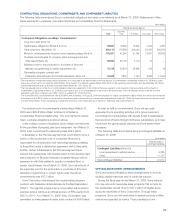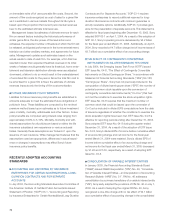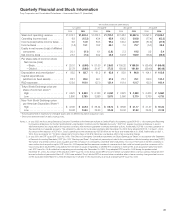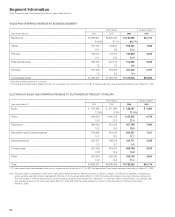Sony 2006 Annual Report Download - page 74
Download and view the complete annual report
Please find page 74 of the 2006 Sony annual report below. You can navigate through the pages in the report by either clicking on the pages listed below, or by using the keyword search tool below to find specific information within the annual report.72
In the area of semiconductors, in the fiscal years ended March 31,
2005 and 2006, Sony carried out ¥150 billion and ¥140 billion,
respectively, of capital expenditure mainly on system large scale
integrations (“LSI”) and CCDs. These totals also include Sony’s
investment in semiconductor fabrication equipment built at the
65 nanometer process technology level. Chips that will be
manufactured using this equipment will be some of the most
highly advanced on the market, and will include system LSI,
in particular the Cell microprocessor, for anticipated use in
the next generation computer entertainment system, PS3,
as well as digital consumer electronics products for the
broadband era. Over the last five years, Sony, Sony Computer
Entertainment, IBM Corporation (“IBM”) and Toshiba Corporation
(“Toshiba”) have carried out joint development focused on 90
and 65 nanometer process technology for utilization in the design
and manufacturing of the Cell microprocessor. Moreover, in 2006
Sony Corporation, IBM, and Toshiba concluded a new joint
development agreement to begin a new 5-year alliance for the
research and development of advanced semiconductor
technology.
In the area of other key devices, S-LCD, Sony’s joint venture
with Samsung Electronics Co., Ltd. based in South Korea,
started production of 7th generation amorphous TFT LCD panel
(glass panel size: approximately 1,870mm x 2,200mm) in April
2005 and since October 2005 has been producing 60,000
sheets a month. In July 2006, S-LCD increased its production
capacity to 75,000 panels a month, and further investment has
been committed that will raise its production capacity to 90,000
panels at the start of calendar 2007. The total amount of these
new investments, to be self-financed by S-LCD, is approximately
¥10 billion and approximately ¥28 billion, respectively.
In July 2006, Sony and Samsung signed the final contract
regarding the manufacturing of 8th generation TFT LCD panels
(glass panel size: approximately 2,200mm x 2,500mm) at the
S-LCD joint venture. The total amount of the investment is
expected to be approximately $1.9 billion (approximately 50%
of which will be borne by Sony), targeting a production capacity
of 50,000 panels a month from fall 2007.
■GAME
In the Game segment, although it is anticipated that the size
of the PS2 business, six years into its business cycle after its
domestic launch in Japan in March 2000, will begin to contract,
SCE will endeavor to maintain a continued high share of the
global game console market for both PS2 hardware and
software. Furthermore, through the addition of software and
hardware system upgrades and new peripherals, which will work
in tandem with PSP software to propose new ways of enjoying
the handheld, SCE will promote further penetration of the
platform. In addition, the new PS3 computer entertainment
platform is scheduled to launch in November 2006. Through the
provision of an appealing software lineup, SCE will promote the
launch of the PS3 platform.
■PICTURES
In the Pictures segment, Sony faces intense competition, rising
advertising and promotion expenses and a growing trend
toward digital piracy. In addition, the DVD format is nine years old
and is showing signs of maturation. To meet these challenges,
Sony is working to distribute a diversified portfolio of motion
pictures with broad worldwide appeal on existing and new home
entertainment formats, including Blu-ray, and other emerging
platforms, including digital download.
■FINANCIAL SERVICES
In the Financial Services segment, the value of assets accumu-
lated by the businesses in the segment has grown continuously
over the past several years, resulting in a large portion
(approximately 43%) of Sony’s total assets being accounted for
by the Financial Services segment. To strengthen asset
management and risk management in parallel with this growing
asset value, enhance disclosure of business details, and offer
customers integrated financial services tailored to their individual
needs, in April 2004 Sony established Sony Financial Holdings
Inc., a holding company overseeing Sony Life, Sony Assurance
and Sony Bank, with the aim of both increasing the synergies
between these businesses and targeting an initial public offering
at some point in the fiscal year ending March 31, 2008 or sub-
sequent fiscal year thereafter, as deemed appropriate by Sony
after taking into account equity market conditions.
CRITICAL ACCOUNTING POLICIES
The preparation of the consolidated financial statements in
conformity with U.S. GAAP requires management to make
estimates and assumptions that affect the reported amounts of
assets and liabilities, disclosure of contingent assets and
liabilities at the date of the financial statements and the reported
amounts of revenues and expenses during the reporting period.
On an ongoing basis, Sony evaluates its estimates which are
based on historical experience and on various other assump-
tions that are believed to be reasonable under the circum-
stances. The results of these evaluations form the basis for
making judgments about the carrying values of assets and
liabilities and the reported amounts of expenses that are not
readily apparent from other sources. Actual results may differ
from these estimates under different assumptions. Sony
considers an accounting policy to be critical if it is important to
its financial condition and results, and requires significant
























